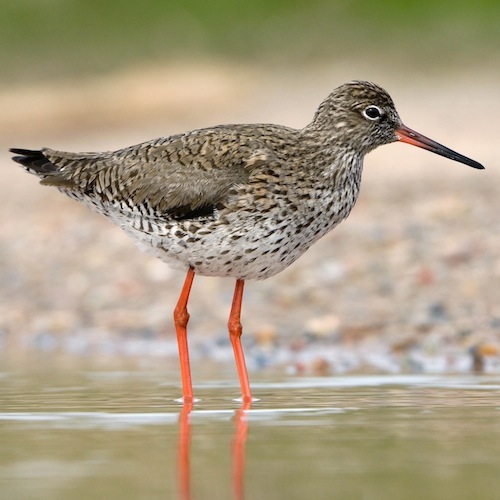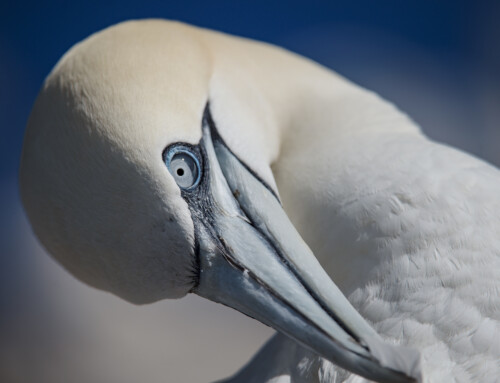Does light grazing of saltmarshes cause nest mortality in Common Redshank?
LINKED PAPER
Light grazing of saltmarshes is a direct and indirect cause of nest failure in Common Redshank Tringa totanus.
Elwyn Sharps, Jennifer Smart, Martin W. Skov, Angus Garbutt & Jan G. Hiddink. 2015.
IBIS. DOI: 10.1111/ibi.12249
The Common Redshank Tringa totanus is known as the “the guardian of the marsh” because they make a loud warning cry at the first sign of an intruder, and are often seen on top of fence posts, looking down over their chicks.
Throughout Europe the populations of many breeding wader species have decreased, with a number of these declines linked to agricultural intensification and the associated loss of breeding habitats. Saltmarshes are internationally important for Redshank, in Britain they hold around half of the breeding population. This is around 9% of north-west Europe’s estimated 100,000 – 172,000 breeding pairs. However, recent surveys of British saltmarshes found a 53% decline in nesting Redshank pairs between 1985 and 2011 and it has been suggested that conservation management has failed to reverse historic Redshank declines. Grazing is perhaps the most widespread conservation management technique on saltmarshes, so this project investigated the effects of grazing on Redshank nest survival.

Livestock can also reduce Redshank nest survival by trampling nests. Nest predation rates may also be indirectly increased by grazing, either through decreasing nest cover and vegetation heterogeneity, therefore making it easier for predators to find nests, or by reducing the amount of unoccupied patches of long vegetation that must be searched by a predator in order to find a nest. An analysis of European studies found that >50% of wader nests were predated in >55% of the 544 examples that they reviewed. Potential Redshank nest predators on British saltmarshes include corvids Corvus spp., gulls Larus spp., Red Foxes Vulpes vulpes, Stoats Mustela ermine and non-native American Mink Neovison vison.

In our IBIS paper, we estimate Redshank nest survival over a range of livestock densities on six lightly grazed saltmarshes in the Ribble estuary in north-west England. We hypothesise that higher grazing pressure results in increased nest mortality: (1) directly through cattle trampling, and (2) indirectly through grazer modification of habitat that accelerates predation risks.
Results showed that risk of nest loss to trampling increased from 16% at 0.15 cattle per hectare to 98% at 0.82 cattle per hectare. The risk of a nest being predated increased from 28% with no grazing to 95% at 0.55 cattle per hectare based on all year grazing data. These results suggest that even light conservation grazing at less than one cattle per hectare can reduce Redshank nest survival rates to near zero.
This work does not suggest that stopping livestock grazing on saltmarshes altogether will result in increased breeding populations of Redshank. Cessation of grazing in previously grazed saltmarshes can result in reductions in breeding Redshank as the vegetation becomes dominated by tall uniform vegetation. However, it may be appropriate to reduce saltmarsh grazing intensities, or change the timing of saltmarsh grazing to reduce the number of livestock present during the Redshank breeding season.
Further reading
Adnitt, C., Brew, D., Cottle, R., Hardwick, M., John, S., Leggett, D., McNulty, S., Meakins, N. & Staniland, R. (2007) Saltmarsh management manual. Environment Agency, Bristol, UK.
Baines, D. (1990) The roles of predation, food and agricultural practice in determining the breeding success of the lapwing (Vanellus vanellus) on upland grasslands. Journal of Animal Ecology 59: 915-929.
Batten, L., Bibby, C., Clement, P., Elliott, G. & Porter, R. (2010) Red data birds in Britain. Poyser, London.
Beintema, A.J. & Muskens, G.J.D.M. (1987) Nesting Success of Birds Breeding in Dutch Agricultural Grasslands. Journal of Applied Ecology 24: 743-758.
Brindley, E., Norris, K., Cook, T., Babbs, S., Brown, C.F., Massey, P., Thompson, R. & Yaxley, R. (1998) The abundance and conservation status of redshank Tringa totanus nesting on saltmarshes in Great Britain. Biological Conservation 86: 289-297.
Cadbury, C., Green, R. & Allport, G. (1987) Redshanks and other breeding waders of British saltmarshes. RSPB Conservation Review 1: 37-40.
Chalfoun, A.D. & Martin, T.E. (2009) Habitat structure mediates predation risk for sedentary prey: experimental tests of alternative hypotheses. Journal of Animal Ecology 78: 497-503.
Donald, P.F., Green, R.E. & Heath, M.F. (2001) Agricultural intensification and the collapse of Europe’s farmland bird populations. Proceedings of the Royal Society of London, Series B: Biological Sciences 268: 25-29.
Hale, W.G. (1980) Waders (New Naturalist Series number 54). Collins, London.
Hart, J.D., Milsom, T., Baxter, A., Kelly, P.F. & Parkin, W.K. (2002) The impact of livestock on Lapwing Vanellus vanellus breeding densities and performance on coastal grazing marsh: Even at very low stocking densities, livestock reduce breeding densities of adult Lapwings and increase the risk of nest loss due to predation. Bird Study 49: 67-78.
Jensen, A. (1985) The effect of cattle and sheep grazing on salt-marsh vegetation at Skallingen, Denmark. Vegetatio 60: 37-48.
Kiehl, K., I., E., Gettner, S. & Walter, J. (1996) Impact of different sheep grazing intensities on salt marsh vegetation in Northern Germany. Journal of Vegetation Science 7: 99-106.
Macdonald, M.A. & Bolton, M. (2008) Predation on wader nests in Europe. Ibis 150, 54-73.
Malpas, L.R., Smart, J., Drewitt, A., Sharps, E. & Garbutt, A. (2013) Continued declines of Redshank Tringa totanus breeding on saltmarsh in Great Britain: is there a solution to this conservation problem? Bird Study60: 1-14.
Mandema, F.S., Tinbergen, J.M., Ens, B.J. & Bakker, J.P. (2014) Spatial Diversity in Canopy Height at Redshank and Oystercatcher Nest-Sites in Relation to Livestock Grazing. Ardea 101: 105-112.
Norris, K., Brindley, E., Cook, T., Babbs, S., Brown, C.F. & Yaxley, R. (1998) Is the density of redshank Tringa totanus nesting on saltmarshes in Great Britain declining due to changes in grazing management? Journal of Applied Ecology 35: 621-634.
Norris, K., Cook, T., O’Dowd, B. & Durdin, C. (1997) The density of redshank Tringa totanus breeding on the salt-marshes of the Wash in relation to habitat and its grazing management. Journal of Applied Ecology35: 999-1013.
Pakanen, V.-M., Luukkonen, A. & Koivula, K. (2011) Nest predation and trampling as management risks in grazed coastal meadows. Biodiversity and Conservation 20: 2057-2073.
Patterson, I. & Burrows, A. (1998) Grazing the wash. Enact 1: 15-17.
Piersma, T. (1986) Breeding waders in Europe: a review of population size estimates and a bibliography of information sources. International Wader Studies 48: 92 – 93.
Smart, J. (2005) Strategies of Sea-level Rise Mitigation for Breeding Redshank. PhD, University of East Anglia.
Thorup, O. (2004) Status of populations and management of dunlin Calidris alpina, ruff Philomachus pugnax and black-tailed godwit Limosa limosa in Denmark. Dansk Orn. Foren. Tidsskr 98: 7-20.
Tucker, G.M., Heath, M.F., Tomialojc, L., Grimmett, R.F. & Socha, C.M. (1994) Birds in Europe: their conservation status. BirdLife International Cambridge.
Vickery, J., Tallowin, J., Feber, R., Asteraki, E., Atkinson, P., Fuller, R. & Brown, V. (2001) The management of lowland neutral grasslands in Britain: effects of agricultural practices on birds and their food resources. Journal of Applied Ecology 38: 647-664.
IMAGE CREDITS:
Common Redshank © Klaas Felix Jachmann
Cattle © Adam Cross
Redshank nest; trampled eggs © Christine Tansey
If you want to write about your research in #theBOUblog, then please see here.






